Sat Mag
Ariesen Ahubudu Accomplished wordsmith of our time

By K. A. I. Kalyanaratne
Consultant – Publications,
Postgraduate Institute of Management,
University of Sri Jayewardenepura.
Vice President, Hela Havula
Who would not be enthralled by the songs ‘Purthugeesi Kaaraya Rataval Allanna Sooraya’, ‘Ko Hathuro Ko Hathuro Ko Apage Hathuro’ and ’Dakuna Nagenahira Batahira Uthura da Eka Kodiye Sevane? Such verbal creations were only possible as he was a Wordsmith par Excellence.
Wordsmiths are men of letters who possess some unique qualities among which are performance of the specialty to the highest standards, with unmatchable skills, and also malleability to use words, to turnout creative and original pieces of work, conforming to the norms of the language. Their writings are eloquent due to the variety and richness of the vocabulary they are able to draw. Such specialists have acquired this skill through a life committed to experimenting with words, particularly their usage in different settings, and continuous researching the meanings of words. Ariesen Ahubudu made use of his wordsmithery through his exhaustive array of roles as writer, playwright, lyricist, poet, lexicographer and journalist.
Ariesen Ahubudu – His initial
guiding influence
Under the tutelage of that master wordsmith Kumaratunga Munidasa, Ariesen Ahubudu tasted the richness of the Sinhala language in all its varied facets. His ‘Kumaratungu Asura’ (Association with Kumaratunga Munidasa) spells out in sufficient detail Kumaratunga’s influence over the shaping of Ahubudu’s character, and how he became an accomplished wordsmith. Of course, his close association with such scholars like Jayantha Weerasekara, Jayamaha Vellala, Abiram Gamhewa and Raphael Tennekoon, had for sure, a marked impact on his future literary works.
Ahubudu – The Lexicographer
One of the main tasks of a wordsmith is to indulge in lexicographic pursuits. Words being the basic component of a language, a key mission of a wordsmith is to explore and inquire into the etymology of words; i.e. how they are formed and the rules followed in their formation. The clarity of a sentence is determined by correct word-usage and syntactic perfection. Ahubudu was on a crusade to zealously discover the etymology of the two major components of the Sinhala language, namely, nouns and verbs.
Two Epic research publications: ‘Lanka Gam Nam Vahara’ and ‘Arutha Nirutha’
Two of his publications that showed his etymological prowess are ‘Lanka Gam Nam Vahara’ and ‘Arutha Nirutha’. ‘Lanka Gam Nam Vahara’, a monograph of the place names of the island is an epic research on the origins of the island’s place names. Aelian de Silva, Chartered Engineer and Linguist, providing an introduction to this lexicon says
“The author has brought to bear his extensive knowledge, not only of the Sinhala language, but also of the long history of the Sinhala people. His knowledge of Sanskrit, Pali and English has placed him in good stead to handle this important task. Such attributes are very essential to intelligently collate the place names, to study the effect on them of linguistic norms, and to analyse them in the light of the historical background…”
Herein Ahubudu’s task had been a painstaking one. In many instances, where the correlation of words and their meanings have got blurred due to subsequent historical developments, he went to the extent of correlating their meanings with the topography and other features. This has been, indeed, a ‘very intelligent approach, and one that has shed much light’ on the origins of place names. The index to this lexicon provides a collection of 1730 place names, and this collection, for sure, would provide a base for any future undertakings of a similar nature. As exposed in this lexicon Bimtenne (Bintenne) is now known as Mahiyangana, which is the Pali translation. From it our Sandesa poets coined Miyungunu. Bimtenne and Miyungunu are now considered as two different places!
Commonalities adopted in the
coining of Place Names
A further step taken in his ‘research’ has been to expose the common grammatical norms/structures that had been followed by our forefathers in coining place names. This exercise itself elevates Ahubudu’s endeavour to much greater heights. This is a task which would have been accomplished by a higher seat of learning. In short it is a monumental task. He has brought these names under nine categories, depending on the rules of grammar followed in their formation, and under each category he cites examples.
For example kirillapane has been formed by the combination of kirilla (cork-tree) and Pane which means ‘a place’. Herein he cites several other place-names that have originated in this manner, namely, Marapane, Tumpane (Tumbapane), Walapane, and Ulapane.
His second lexicon is ‘Arutha Nirutha’, (Meaning and Etymology) an exposition revealing a new dimension in the art of formation and understanding the meanings of the terms in the Sinhala language. Ahubudu, in producing this lexicon worked on the primary premise that “Language used by the various people also helps us to deduce certain facts about their thoughts and aspirations and their knowledge of arts and crafts. That is because man and his language are always connected with words that reflect the environment in which man lived.” Preface to Arutha Nirutha). Herein he quotes Samual Johnson who said that “Language is the pedigree of the nation.” Thus, while Ahubudu brings to light the nation’s broad cultural environment by unearthing the hidden facets of the people, “examines the repetitive patterns relating to the formation of composite words in the language, and elicits the associated principles.
Given below is one of his etymological analyses:
Karawila (kariwila): (gourd = memordica charantia). This word derives its name taking into account its two main features. ‘kara’ is knot or cone. ‘wili’ is wrinkled or corrugated. Hence, Karawila is a combination of ‘kara’ and ‘wili’. (‘wili’ in the Sinhala Bodhi Wamsaya gives the meaning ‘wrinkled’ or ‘folded’).
A Wordsmith’s armoury of words sans grammar and idiomatic usage
If there is no grammar and idiomatic usage of a language only a jumble of words, utterly incapable of expressing one’s thoughts and feelings will remain. Ahubudu while enriching his diction over the years to ensure that he was rich and fully capable of expressing the nuances as well as the shades of meanings, mastered the grammar and idiomatic usage of the language. It is certain that Kumaratunga Munidasa’s two seminal works on Sinhala grammar, i.e., Vyakarana Vivaranaya and Kriya Vivaranaya, played a decisive role in strengthening Ahubudu’s acumen in the usage of Sinhala grammar. However, he had enriched the findings of these two researches, by creating a style of his own, with a fine blend of both classical and spoken idioms. This creative language, stood him in good stead, in his literary works, which included prose, verse as well as drama. J. E. Metcalfe in his ‘Improve Your English” says “Grammar is the basis of a language, the framework on which ideas are hung, and the loftiest imagery of thought can fall flat if ungrammatically expressed. … In all phases of human life there is a need, indeed a desire, for discipline, …The discipline of language is the thing called grammar.”
However, Ahubudu’s approach in disciplining Sinhala was quite different from that of many other publishers of grammar-books. What he did was to re-express grammatical rules in a simpler manner, targeting the young ones, especially school children. As he had been a successful teacher for long years, he knew the art of expressing even knotty grammatical rules in a manner that appeals to the young ones. ‘Detu Rukula’ is mainly aimed at students sitting the GCE ordinary level examination. Ahubudu had also judiciously decided to have a separate publication on ‘separation of words’ in Sinhala, titled, Sinhalaye Pada Beduma. (jointly authored with Liyanage Jinadasa). His decision had been primarily induced by the confusion the students faced in the separation of words in their writings.
Realization of Unique Characteristics
of the Sinhala Language
Every language has its own unique characteristics. This, in fact, is the personality of a language. It is this realization that helped Ahubudu to create literary works without debasing the grammar, language-structures as well as word-forms, as well as to create new words to express new ideas without making them feel as ‘foreign bodies’ or intrusions. The principle followed is to adopt Sinhala verb-roots in the coining of words; a principle that is being adopted by world languages like Russian, French, German and Japanese.
The following verse appended from the song ‘Dakuna – Nagenahira’ alone would be sufficient to show how clever Ahubudu had been not only in the coining of words but also in elucidating completely new meanings to the traditional meanings.
“Ipaduna apa hata lak polove – Suru viru kam upatin huruwe.
Dakvamu daskam lakkam viskam – Vismavamin mulu lo.”
This verse provides a set of new meanings to the traditional renderings provided by our lexicographers. Viskam = marvels; Lakkam = products of Lanka ; Vismavamin (coined as a single word from the two words vismaya and mavanava. Resultantly, in place of two words to express ‘creating wonders’ the Sinhala language has now been enriched by a new word ‘vismavayi’ to express ‘creating wonders’. This word could either be used as a verb by conjugating it as vismavayi, vismavati,vismavami, vismavamu… or as a noun which could be declined as vismavanna, vismavanno, vismavannee…
Malleability of Language
Malleability of language is the capability of stretching a language into different shapes, as demanded of by the occasion or the literary genre, similar to how William Shakespeare began to adapt the traditional styles to suit his own purposes. Any writer who is rich in his diction when uses a language constantly and consciously the ultimate result would be the development of a writing style of his own. In fact, his style of writing becomes unique to him. It is why the style of Gurulugomi (in the Amavatura) differs considerably from that of Dharmasena thero’s Saddharmarathnavaliya. Raphael Tennekoon’s writing style is a product of his own, which is full of satire and locally spun words, as seen in his ‘Gemi Bana’.
Ariesen Ahubudu, in his long years of engagement as a writer, had developed that quality of language-malleability, the end-product of which has been his unique style of writing. The base of his language is the richness of his diction which suits different occasions and different literary genres. A writer’s most prized possession is his or her own unique writing style, which is the single most valuable investment a writer can make. The rules are about what a writer does; style is about how the writer does it.
Vocabulary and Style to suit
All Literary Genres
Unlike prose which is the most common form of writing, Ahubudu, armed with his rich vocabulary and styles discovered through long years of indulgence in versification, showed his prowess by producing works belonging to a host of literary genres: mainly poetry, lyrics and drama. Poetry is accepted as the most intense form of writing among a nation’s literary works.
Ahubudu’s Usage of Words
in Song-lyrics
His poetic and lyrical creations are so exhaustive, that it would not be possible in the space provided to comment on every one of them. The ‘Sakvithi Kith Resa’ (The Collective Fame of the Universal Monarch) compiled and edited by Shrinath Ganewatta, President, Hela Hawula, contains a near total collection of Ahubudu’s song-lyrics. Appended below are two stanzas from the song lyrics of ‘Ko Hathuro’, a song coming in the film ‘Sandesaya’. Ahubudu being blessed with an unboundedly rich vocabulary did not come across any impediment in expressing his sentiments. How wonderful are the new word-clusters he had created to express new meanings as well as to teach a lesson to budding lyricists as to how words could be selectively used to generate new tastes and experiences. Aren’t Kaduwata kaduwai heeyata heeyayi Papuwata papuwai new expressions to accentuate sentiments? A further secret is the choice of words, and that too, to fall in line with the tune.
“Ekakuth apa gen nesuwath hathuran
Un gen seeyak helapiyav
Kaduwata kaduwai heeyata heeyayi
Papuwata papuwai dee palayawu.”
The word combination ‘maruwatath maru wune” in this song expresses several meanings. It’s a literary device normally referred to as ‘pun’. The literary meaning of the combination of these words is that they surpassed even Mara in the act of killing. However, the hidden and subtle meaning Ahubudu wishes to convey is that ‘they brought death even to Mara (demon causing death and destruction to others.)
Ahubudu’s Poetic Compositions
Even if taken as a separate entity, his poetic compositions could be considered as an ‘industry’ of its own. His poetic compositions by way of its volume is incomparable. Two of his compositions that stand tall among the rest of his works are ‘Rasadahara’, an epic poem, and ‘Pareviya – Sama Asna’ a poem that is akin to our Sandesa poems of the Kotte period and the period immediately thereafter, as it contains all the ingredients of the compositions of that genre; the only deviation being that while all our Sandesa poems are happenings confined to the country, Pareviya is devoted to the loadable act of getting a pigeon to carry a message of peace to the three leading countries of China, Russia and the United States of America.
Here again Ahubudu performs miracles with his rich diction and creative-clustering of appropriate words. This is, indeed, a miracle that could only be performed by a high caliber wordsmith. Through his rich verbiage and masterly use of words he draws an enthralling imagery. The messenger ‘pareviya’ (pigeon) is made to realize the rejoicing atmosphere borne of the spring-time by painting a colourful picture, through such words as,
“Mal gomu gumu gumu ganvannee
Mee vadavale peni puravanne
Kurulu sarin kan pinavannee
Mulu lova uyanak karavannee”
Through this verse Ahubudu makes the spring-environment dance in ecstasy. These words also manifest how supple the Sinhala language is. In the same poem the pigeon while flying over Africa he hears the agitation of the Africans against their European rulers, as the African natives now remain a downtrodden community. See how ferociously the poet expresses their feelings:
“Sudda udda padd lav
Bellen alla holla lav
Atten yutten beri nam ovu
Ketten pollen sun kerelavu
Negita varo negita varo
Rotta ma negita varo”
This is a combination of short words and a unique metric composition.
The reader sees through the word-drama the native Africans getting their men to rally round to defeat their oppressors! Herein Ahubudu has become a verbal artist. It is said that an artist dreams a picture and then pictures his dream.
Kalanaruwan Sumandas, a critique, providing an introduction to Ahubudu’s ‘Rasadahara’ says that the services rendered by Ahubudu to amplify and broad-base Sinhala poetry could only be compared to what Ravindranath Tagore did for Vanga poetry. Every line of every verse in the ‘Rasa Dahara’ manifests the poet’s cleverly coined word-clusters and imagery.
Ahubudu’s Contribution to the Sinhala Language and Literature
A recent publication titled ‘Viritha ha Arutha’ jointly authored by Prof. Wimal Disanayake and Shrinath Ganewatta, President, Hela Havula, attempts at establishing the harmony between meter and meaning. Meaning is based on lyrical composition. A poem is a piece of writing in which the words are chosen for their beauty and sound to produce an intensely imaginative interpretation of the subject. Based on this definition Ahubudu as a wordsmith, through his wondrous lyrical compositions has, for certain, stolen the hearts of the reader.
Cited below is an instance Ahubudu became a word-artist through his pen-brush to command a river to flow for the service of humanity. The poet while challenging the river to empty its waters to the sea, without helping the mankind, also indirectly challenges anyone to make a lyrical composition expressing the same sentiments, within the same or similar metric composition, to this effect!
“Emba ganga
Navatinu navatinu navatinu navatinu gangave.
Kanda kapav
Gal peralavu
Veli bandiv
Gamana bindiv
Gangave
Conclusion – A Cursory Treatment
Ariesen Ahubudu’s life-long commitment delving deep into the origins of Sinhala words, unearthing the grammatical bases of our place names, rendering a yeoman service by reproducing rules of grammar to the younger generation, setting examples by way of showing how the language could be used malleably to express innate, inner and deep thoughts and sentiments, and making Sinhala both a lovable and lively medium that could be moulded to suit all occasions, demand a deeper analysis and research. Ariesen Ahubudu is a living embodiment of executing what he had found and preached, for the furtherance of the Sinhala language and literature. In this committed attempt he hailed through example that the Sinhala verse as a medium of expression is equal to such attempts that have been made by any other world language. Herein, his indirect message is “a nation which is incapable of poetry is incapable of any kind of literature except the cleverness of a decadence”. It is, therefore, apt to conclude this short essay with a quotation of Goethe (considered as the greatest German literary figure of the modern era), as it fits in well with the tasks and the mission Ariesen Ahubudu fulfilled during the tenure of his life.
“Knowing is not enough;
We must apply.
Willing is not enough;
We must do.”
-Goethe-
Sat Mag
October 13 at the Women’s T20 World Cup: Injury concerns for Australia ahead of blockbuster game vs India
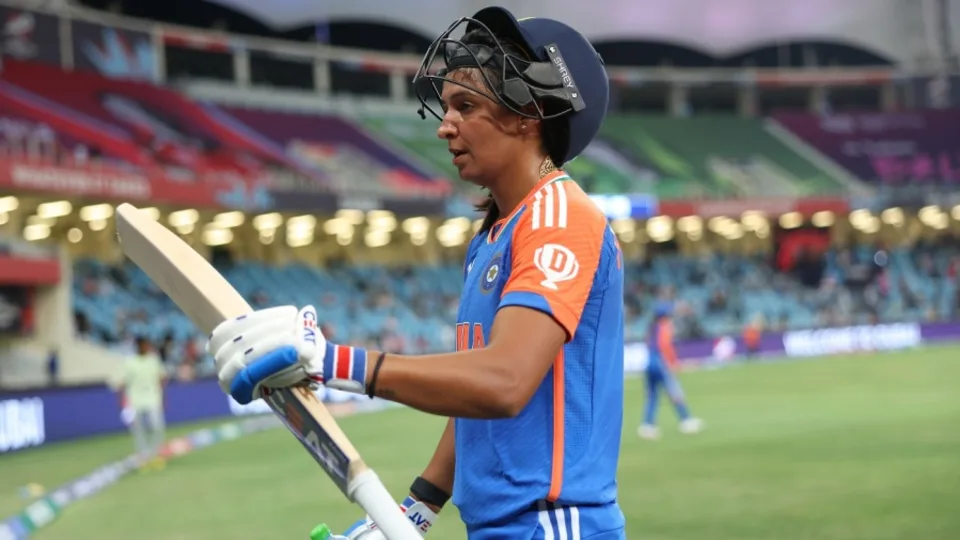
Australia vs India
Sharjah, 6pm local time
Australia have major injury concerns heading into the crucial clash. Just four balls into the match against Pakistan, Tayla Vlaeminck was out with a right shoulder dislocation. To make things worse, captain Alyssa Healy suffered an acute right foot injury while batting on 37 as she hobbled off the field with Australia needing 14 runs to win. Both players went for scans on Saturday.
India captain Harmanpreet Kaur who had hurt her neck in the match against Pakistan, turned up with a pain-relief patch on the right side of her neck during the Sri Lanka match. She also didn’t take the field during the chase. Fast bowler Pooja Vastrakar bowled full-tilt before the Sri Lanka game but didn’t play.
India will want a big win against Australia. If they win by more than 61 runs, they will move ahead of Australia, thereby automatically qualifying for the semi-final. In a case where India win by fewer than 60 runs, they will hope New Zealand win by a very small margin against Pakistan on Monday. For instance, if India make 150 against Australia and win by exactly 10 runs, New Zealand need to beat Pakistan by 28 runs defending 150 to go ahead of India’s NRR. If India lose to Australia by more than 17 runs while chasing a target of 151, then New Zealand’s NRR will be ahead of India, even if Pakistan beat New Zealand by just 1 run while defending 150.
Overall, India have won just eight out of 34 T20Is they’ve played against Australia. Two of those wins came in the group-stage games of previous T20 World Cups, in 2018 and 2020.
Australia squad:
Alyssa Healy (capt & wk), Darcie Brown, Ashleigh Gardner, Kim Garth, Grace Harris, Alana King, Phoebe Litchfield, Tahlia McGrath, Sophie Molineux, Beth Mooney, Ellyse Perry, Megan Schutt, Annabel Sutherland, Tayla Vlaeminck, Georgia Wareham
India squad:
Harmanpreet Kaur (capt), Smriti Mandhana (vice-capt), Yastika Bhatia (wk), Shafali Verma, Deepti Sharma, Jemimah Rodrigues, Richa Ghosh (wk), Pooja Vastrakar, Arundhati Reddy, Renuka Singh, D Hemalatha, Asha Sobhana, Radha Yadav, Shreyanka Patil, S Sajana
Tournament form guide:
Australia have three wins in three matches and are coming into this contest having comprehensively beaten Pakistan. With that win, they also all but sealed a semi-final spot thanks to their net run rate of 2.786. India have two wins in three games. In their previous match, they posted the highest total of the tournament so far – 172 for 3 and in return bundled Sri Lanka out for 90 to post their biggest win by runs at the T20 World Cup.
Players to watch:
Two of their best batters finding their form bodes well for India heading into the big game. Harmanpreet and Mandhana’s collaborative effort against Pakistan boosted India’s NRR with the semi-final race heating up. Mandhana, after a cautious start to her innings, changed gears and took on Sri Lanka’s spinners to make 50 off 38 balls. Harmanpreet, continuing from where she’d left against Pakistan, played a classic, hitting eight fours and a six on her way to a 27-ball 52. It was just what India needed to reinvigorate their T20 World Cup campaign.
[Cricinfo]
Sat Mag
Living building challenge

By Eng. Thushara Dissanayake
The primitive man lived in caves to get shelter from the weather. With the progression of human civilization, people wanted more sophisticated buildings to fulfill many other needs and were able to accomplish them with the help of advanced technologies. Security, privacy, storage, and living with comfort are the common requirements people expect today from residential buildings. In addition, different types of buildings are designed and constructed as public, commercial, industrial, and even cultural or religious with many advanced features and facilities to suit different requirements.
We are facing many environmental challenges today. The most severe of those is global warming which results in many negative impacts, like floods, droughts, strong winds, heatwaves, and sea level rise due to the melting of glaciers. We are experiencing many of those in addition to some local issues like environmental pollution. According to estimates buildings account for nearly 40% of all greenhouse gas emissions. In light of these issues, we have two options; we change or wait till the change comes to us. Waiting till the change come to us means that we do not care about our environment and as a result we would have to face disastrous consequences. Then how can we change in terms of building construction?
Before the green concept and green building practices come into play majority of buildings in Sri Lanka were designed and constructed just focusing on their intended functional requirements. Hence, it was much likely that the whole process of design, construction, and operation could have gone against nature unless done following specific regulations that would minimize negative environmental effects.
We can no longer proceed with the way we design our buildings which consumes a huge amount of material and non-renewable energy. We are very concerned about the food we eat and the things we consume. But we are not worrying about what is a building made of. If buildings are to become a part of our environment we have to design, build and operate them based on the same principles that govern the natural world. Eventually, it is not about the existence of the buildings, it is about us. In other words, our buildings should be a part of our natural environment.
The living building challenge is a remarkable design philosophy developed by American architect Jason F. McLennan the founder of the International Living Future Institute (ILFI). The International Living Future Institute is an environmental NGO committed to catalyzing the transformation toward communities that are socially just, culturally rich, and ecologically restorative. Accordingly, a living building must meet seven strict requirements, rather certifications, which are called the seven “petals” of the living building. They are Place, Water, Energy, Equity, Materials, Beauty, and Health & Happiness. Presently there are about 390 projects around the world that are being implemented according to Living Building certification guidelines. Let us see what these seven petals are.
Place
This is mainly about using the location wisely. Ample space is allocated to grow food. The location is easily accessible for pedestrians and those who use bicycles. The building maintains a healthy relationship with nature. The objective is to move away from commercial developments to eco-friendly developments where people can interact with nature.
Water
It is recommended to use potable water wisely, and manage stormwater and drainage. Hence, all the water needs are captured from precipitation or within the same system, where grey and black waters are purified on-site and reused.
Energy
Living buildings are energy efficient and produce renewable energy. They operate in a pollution-free manner without carbon emissions. They rely only on solar energy or any other renewable energy and hence there will be no energy bills.
Equity
What if a building can adhere to social values like equity and inclusiveness benefiting a wider community? Yes indeed, living buildings serve that end as well. The property blocks neither fresh air nor sunlight to other adjacent properties. In addition, the building does not block any natural water path and emits nothing harmful to its neighbors. On the human scale, the equity petal recognizes that developments should foster an equitable community regardless of an individual’s background, age, class, race, gender, or sexual orientation.
Materials
Materials are used without harming their sustainability. They are non-toxic and waste is minimized during the construction process. The hazardous materials traditionally used in building components like asbestos, PVC, cadmium, lead, mercury, and many others are avoided. In general, the living buildings will not consist of materials that could negatively impact human or ecological health.
Beauty
Our physical environments are not that friendly to us and sometimes seem to be inhumane. In contrast, a living building is biophilic (inspired by nature) with aesthetical designs that beautify the surrounding neighborhood. The beauty of nature is used to motivate people to protect and care for our environment by connecting people and nature.
Health & Happiness
The building has a good indoor and outdoor connection. It promotes the occupants’ physical and psychological health while causing no harm to the health issues of its neighbors. It consists of inviting stairways and is equipped with operable windows that provide ample natural daylight and ventilation. Indoor air quality is maintained at a satisfactory level and kitchen, bathrooms, and janitorial areas are provided with exhaust systems. Further, mechanisms placed in entrances prevent any materials carried inside from shoes.
The Bullitt Center building
Bullitt Center located in the middle of Seattle in the USA, is renowned as the world’s greenest commercial building and the first office building to earn Living Building certification. It is a six-story building with an area of 50,000 square feet. The area existed as a forest before the city was built. Hence, the Bullitt Center building has been designed to mimic the functions of a forest.
The energy needs of the building are purely powered by the solar system on the rooftop. Even though Seattle is relatively a cloudy city the Bullitt Center has been able to produce more energy than it needed becoming one of the “net positive” solar energy buildings in the world. The important point is that if a building is energy efficient only the area of the roof is sufficient to generate solar power to meet its energy requirement.
It is equipped with an automated window system that is able to control the inside temperature according to external weather conditions. In addition, a geothermal heat exchange system is available as the source of heating and cooling for the building. Heat pumps convey heat stored in the ground to warm the building in the winter. Similarly, heat from the building is conveyed into the ground during the summer.
The potable water needs of the building are achieved by treating rainwater. The grey water produced from the building is treated and re-used to feed rooftop gardens on the third floor. The black water doesn’t need a sewer connection as it is treated to a desirable level and sent to a nearby wetland while human biosolid is diverted to a composting system. Further, nearly two third of the rainwater collected from the roof is fed into the groundwater and the process resembles the hydrologic function of a forest.
It is encouraging to see that most of our large-scale buildings are designed and constructed incorporating green building concepts, which are mainly based on environmental sustainability. The living building challenge can be considered an extension of the green building concept. Amanda Sturgeon, the former CEO of the ILFI, has this to say in this regard. “Before we start a project trying to cram in every sustainable solution, why not take a step outside and just ask the question; what would nature do”?
Sat Mag
Something of a revolution: The LSSP’s “Great Betrayal” in retrospect
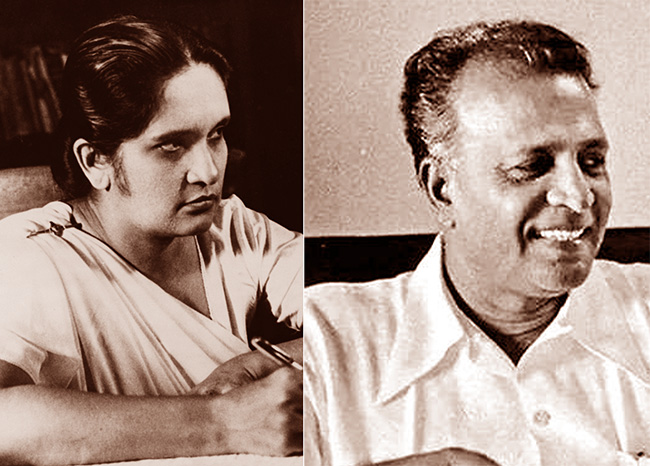
By Uditha Devapriya
On June 7, 1964, the Central Committee of the Lanka Sama Samaja Party convened a special conference at which three resolutions were presented. The first, moved by N. M. Perera, called for a coalition with the SLFP, inclusive of any ministerial portfolios. The second, led by the likes of Colvin R. de Silva, Leslie Goonewardena, and Bernard Soysa, advocated a line of critical support for the SLFP, but without entering into a coalition. The third, supported by the likes of Edmund Samarakkody and Bala Tampoe, rejected any form of compromise with the SLFP and argued that the LSSP should remain an independent party.
The conference was held a year after three parties – the LSSP, the Communist Party, and Philip Gunawardena’s Mahajana Eksath Peramuna – had founded a United Left Front. The ULF’s formation came in the wake of a spate of strikes against the Sirimavo Bandaranaike government. The previous year, the Ceylon Transport Board had waged a 17-day strike, and the harbour unions a 60-day strike. In 1963 a group of working-class organisations, calling itself the Joint Committee of Trade Unions, began mobilising itself. It soon came up with a common programme, and presented a list of 21 radical demands.
In response to these demands, Bandaranaike eventually supported a coalition arrangement with the left. In this she was opposed, not merely by the right-wing of her party, led by C. P. de Silva, but also those in left parties opposed to such an agreement, including Bala Tampoe and Edmund Samarakkody. Until then these parties had never seen the SLFP as a force to reckon with: Leslie Goonewardena, for instance, had characterised it as “a Centre Party with a programme of moderate reforms”, while Colvin R. de Silva had described it as “capitalist”, no different to the UNP and by default as bourgeois as the latter.
The LSSP’s decision to partner with the government had a great deal to do with its changing opinions about the SLFP. This, in turn, was influenced by developments abroad. In 1944, the Fourth International, which the LSSP had affiliated itself with in 1940 following its split with the Stalinist faction, appointed Michel Pablo as its International Secretary. After the end of the war, Pablo oversaw a shift in the Fourth International’s attitude to the Soviet states in Eastern Europe. More controversially, he began advocating a strategy of cooperation with mass organisations, regardless of their working-class or radical credentials.
Pablo argued that from an objective perspective, tensions between the US and the Soviet Union would lead to a “global civil war”, in which the Soviet Union would serve as a midwife for world socialist revolution. In such a situation the Fourth International would have to take sides. Here he advocated a strategy of entryism vis-à-vis Stalinist parties: since the conflict was between Stalinist and capitalist regimes, he reasoned, it made sense to see the former as allies. Such a strategy would, in his opinion, lead to “integration” into a mass movement, enabling the latter to rise to the level of a revolutionary movement.

Though controversial, Pablo’s line is best seen in the context of his times. The resurgence of capitalism after the war, and the boom in commodity prices, had a profound impact on the course of socialist politics in the Third World. The stunted nature of the bourgeoisie in these societies had forced left parties to look for alternatives. For a while, Trotsky had been their guide: in colonial and semi-colonial societies, he had noted, only the working class could be expected to see through a revolution. This entailed the establishment of workers’ states, but only those arising from a proletarian revolution: a proposition which, logically, excluded any compromise with non-radical “alternatives” to the bourgeoisie.
To be sure, the Pabloites did not waver in their support for workers’ states. However, they questioned whether such states could arise only from a proletarian revolution. For obvious reasons, their reasoning had great relevance for Trotskyite parties in the Third World. The LSSP’s response to them showed this well: while rejecting any alliance with Stalinist parties, the LSSP sympathised with the Pabloites’ advocacy of entryism, which involved a strategic orientation towards “reformist politics.” For the world’s oldest Trotskyite party, then going through a series of convulsions, ruptures, and splits, the prospect of entering the reformist path without abandoning its radical roots proved to be welcoming.
Writing in the left-wing journal Community in 1962, Hector Abhayavardhana noted some of the key concerns that the party had tried to resolve upon its formation. Abhayavardhana traced the LSSP’s origins to three developments: international communism, the freedom struggle in India, and local imperatives. The latter had dictated the LSSP’s manifesto in 1936, which included such demands as free school books and the use of Sinhala and Tamil in the law courts. Abhayavardhana suggested, correctly, that once these imperatives changed, so would the party’s focus, though within a revolutionary framework. These changes would be contingent on two important factors: the establishment of universal franchise in 1931, and the transfer of power to the local bourgeoisie in 1948.
Paradoxical as it may seem, the LSSP had entered the arena of radical politics through the ballot box. While leading the struggle outside parliament, it waged a struggle inside it also. This dual strategy collapsed when the colonial government proscribed the party and the D. S. Senanayake government disenfranchised plantation Tamils. Suffering two defeats in a row, the LSSP was forced to think of alternatives. That meant rethinking categories such as class, and grounding them in the concrete realities of the country.
This was more or less informed by the irrelevance of classical and orthodox Marxian analysis to the situation in Sri Lanka, specifically to its rural society: with a “vast amorphous mass of village inhabitants”, Abhayavardhana observed, there was no real basis in the country for a struggle “between rich owners and the rural poor.” To complicate matters further, reforms like the franchise and free education, which had aimed at the emancipation of the poor, had in fact driven them away from “revolutionary inclinations.” The result was the flowering of a powerful rural middle-class, which the LSSP, to its discomfort, found it could not mobilise as much as it had the urban workers and plantation Tamils.
Where else could the left turn to? The obvious answer was the rural peasantry. But the rural peasantry was in itself incapable of revolution, as Hector Abhayavardhana has noted only too clearly. While opposing the UNP’s Westernised veneer, it did not necessarily oppose the UNP’s overtures to Sinhalese nationalism. As historians like K. M. de Silva have observed, the leaders of the UNP did not see their Westernised ethos as an impediment to obtaining support from the rural masses. That, in part at least, was what motivated the Senanayake government to deprive Indian estate workers of their most fundamental rights, despite the existence of pro-minority legal safeguards in the Soulbury Constitution.
To say this is not to overlook the unique character of the Sri Lankan rural peasantry and petty bourgeoisie. Orthodox Marxists, not unjustifiably, characterise the latter as socially and politically conservative, tilting more often than not to the right. In Sri Lanka, this has frequently been the case: they voted for the UNP in 1948 and 1952, and voted en masse against the SLFP in 1977. Yet during these years they also tilted to the left, if not the centre-left: it was the petty bourgeoisie, after all, which rallied around the SLFP, and supported its more important reforms, such as the nationalisation of transport services.
One must, of course, be wary of pasting the radical tag on these measures and the classes that ostensibly stood for them. But if the Trotskyite critique of the bourgeoisie – that they were incapable of reform, even less revolution – holds valid, which it does, then the left in the former colonies of the Third World had no alternative but to look elsewhere and to be, as Abhayavardhana noted, “practical men” with regard to electoral politics. The limits within which they had to work in Sri Lanka meant that, in the face of changing dynamics, especially among the country’s middle-classes, they had to change their tactics too.
Meanwhile, in 1953, the Trotskyite critique of Pabloism culminated with the publication of an Open Letter by James Cannon, of the US Socialist Workers’ Party. Cannon criticised the Pabloite line, arguing that it advocated a policy of “complete submission.” The publication of the letter led to the withdrawal of the International Committee of the Fourth International from the International Secretariat. The latter, led by Pablo, continued to influence socialist parties in the Third World, advocating temporary alliances with petty bourgeois and centrist formations in the guise of opposing capitalist governments.
For the LSSP, this was a much-needed opening. Even as late as 1954, three years after S. W. R. D. Bandaranaike formed the SLFP, the LSSP continued to characterise the latter as the alternative bourgeois party in Ceylon. Yet this did not deter it from striking up no contest pacts with Bandaranaike at the 1956 election, a strategy that went back to November 1951, when the party requested the SLFP to hold a discussion about the possibility of eliminating contests in the following year’s elections. Though it extended critical support to the MEP government in 1956, the LSSP opposed the latter once it enacted emergency measures in 1957, mobilising trade union action for a period of three years.
At the 1960 election the LSSP contested separately, with the slogan “N. M. for P.M.” Though Sinhala nationalism no longer held sway as it had in 1956, the LSSP found itself reduced to a paltry 10 seats. It was against this backdrop that it began rethinking its strategy vis-à-vis the ruling party. At the throne speech in April 1960, Perera openly declared that his party would not stabilise the SLFP. But a month later, in May, he called a special conference, where he moved a resolution for a coalition with the party. As T. Perera has noted in his biography of Edmund Samarakkody, the response to the resolution unearthed two tendencies within the oppositionist camp: the “hardliners” who opposed any compromise with the SLFP, including Samarakkody, and the “waverers”, including Leslie Goonewardena.
These tendencies expressed themselves more clearly at the 1964 conference. While the first resolution by Perera called for a complete coalition, inclusive of Ministries, and the second rejected a coalition while extending critical support, the third rejected both tactics. The outcome of the conference showed which way these tendencies had blown since they first manifested four years earlier: Perera’s resolution obtained more than 500 votes, the second 75 votes, the third 25. What the anti-coalitionists saw as the “Great Betrayal” of the LSSP began here: in a volte-face from its earlier position, the LSSP now held the SLFP as a party of a radical petty bourgeoisie, capable of reform.
History has not been kind to the LSSP’s decision. From 1970 to 1977, a period of less than a decade, these strategies enabled it, as well as the Communist Party, to obtain a number of Ministries, as partners of a petty bourgeois establishment. This arrangement collapsed the moment the SLFP turned to the right and expelled the left from its ranks in 1975, in a move which culminated with the SLFP’s own dissolution two years later.
As the likes of Samarakkody and Meryl Fernando have noted, the SLFP needed the LSSP and Communist Party, rather than the other way around. In the face of mass protests and strikes in 1962, the SLFP had been on the verge of complete collapse. The anti-coalitionists in the LSSP, having established themselves as the LSSP-R, contended later on that the LSSP could have made use of this opportunity to topple the government.
Whether or not the LSSP could have done this, one can’t really tell. However, regardless of what the LSSP chose to do, it must be pointed out that these decades saw the formation of several regimes in the Third World which posed as alternatives to Stalinism and capitalism. Moreover, the LSSP’s decision enabled it to see through certain important reforms. These included Workers’ Councils. Critics of these measures can point out, as they have, that they could have been implemented by any other regime. But they weren’t. And therein lies the rub: for all its failings, and for a brief period at least, the LSSP-CP-SLFP coalition which won elections in 1970 saw through something of a revolution in the country.
The writer is an international relations analyst, researcher, and columnist based in Sri Lanka who can be reached at udakdev1@gmail.com
-

 Features5 days ago
Features5 days agoFinally, Mahinda Yapa sets the record straight
-

 News7 days ago
News7 days agoOver 35,000 drug offenders nabbed in 36 days
-
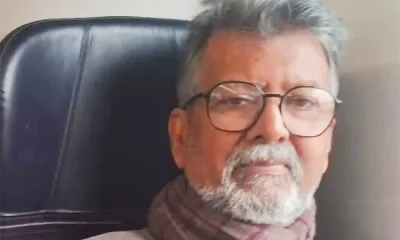
 News6 days ago
News6 days agoCyclone Ditwah leaves Sri Lanka’s biodiversity in ruins: Top scientist warns of unseen ecological disaster
-

 News7 days ago
News7 days agoRising water level in Malwathu Oya triggers alert in Thanthirimale
-
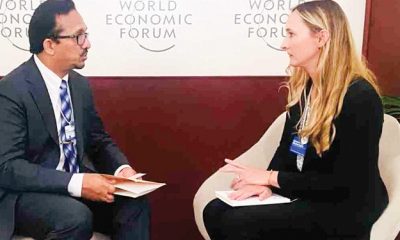
 Features5 days ago
Features5 days agoHandunnetti and Colonial Shackles of English in Sri Lanka
-
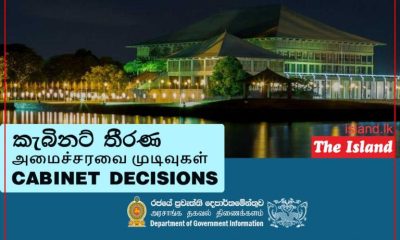
 Business3 days ago
Business3 days agoCabinet approves establishment of two 50 MW wind power stations in Mullikulum, Mannar region
-

 Business7 days ago
Business7 days agoSri Lanka betting its tourism future on cold, hard numbers
-

 News6 days ago
News6 days agoJetstar to launch Australia’s only low-cost direct flights to Sri Lanka, with fares from just $315^













